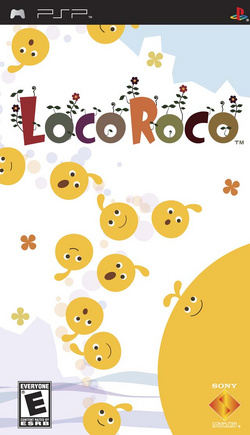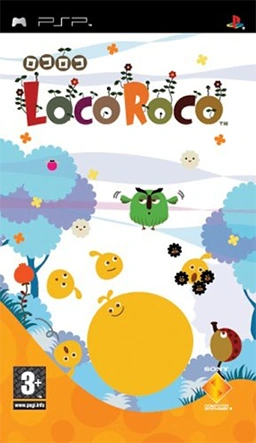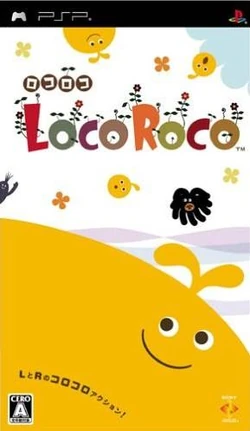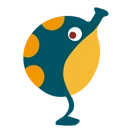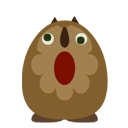- This article is about the first and original game in the series. For the article about the jelly blob-like creatures of the same name, see LocoRoco (species).
| Information | |
| Developer(s) | SCE Japan Studio |
| Publisher(s) | Sony Computer Entertainment |
| Designer(s) | Tsutomu Kouno |
| Artist(s) | Keigo Tsuchiya |
| Platform(s) | PlayStation Portable Java ME PlayStation 4 |
| Release date(s) | June 23, 2006 (EU) July 13, 2006 (JP) |
| Genre(s) | Platformer, Puzzle |
| Mode(s) | Single-player |
| Game List | |
| Predecessor | N/A |
| Successor | LocoRoco Cocoreccho! |
| This page uses Creative Commons Licensed content from Wikipedia (view authors). |
LocoRoco (pronunciation: Locɔːrocɔː) is a platform game for the PlayStation Portable released in 2006 and the first installment of the LocoRoco franchise. It is developed and published by Sony Computer Entertainment.
Plot[]
A group of joyful blob-like creatures, called the LocoRocos, live on a planet filled with natural beauty. But then, a meteorite crashes into the universe. Suddenly, a army of Mojas invade the planet, attempting to attack the LocoRocos. Meanwhile, some of the Mojas begin draining the planet of its lifeforce. The planet wakes up to investigate the disaster striking the universe. Kulche, a fun-loving yellow creature, defeats one of the Moja corp members, but the other Mojas finds out about this and chase after him.
Gameplay[]
LocoRoco is divided into 5 worlds, each consisting of 8 levels. In each level, the goal is to reach the end point of the level, with the player scored on the number of LocoRocos found, the time to complete the level, and other factors. There are six varieties of LocoRoco in the game, identified by their color, appearance, and musical voice, but outside of the first yellow one (Kulche), the rest are unlocked as the player completes the levels. The player can then opt which LocoRoco they want to use for a level, however, this selection has no fundamental gameplay effects and only changes the songs used. LocoRoco act as blobs of gelatin, deforming from their normally round shape when demanded by the environment. Certain beings in the world can change the default shape of the LocoRoco into other forms, such as squares or triangles, which lasts until they wash off in water or they encounter another similar being.
The player starts with a single LocoRoco. When a LocoRoco eats a berry, it grows by one, up to a maximum size of twenty. The single large LocoRoco may be split into individual beings by pressing "O" or through specific points on the level, while individual LocoRoco can merge back into a single being by holding down "O". Manipulation of the LocoRoco in this manner may be necessary to guide them to the finish. While the single large LocoRoco is easier to control, small passages can only be navigated by individual LocoRoco. The player can lose LocoRocos if they are touched by harmful objects or they run into the Moja, and the game will be over if they lose all their LocoRoco. With the exception of making them jump, the player does not otherwise directly control the LocoRoco, but instead controls the planet itself, tilting the planet using the L and R buttons. This causes the LocoRoco to roll in the direction of tilt, as well as causing certain mechanical objects such as platforms to also tilt. The player can also cause the LocoRoco to jump by holding and releasing both buttons. This not only allows the LocoRoco a way to cross gaps, but grants them the ability to burst through walls and harm the Mojas without taking damage. As the player collects more LocoRoco in a level, the music gains more voices, each LocoRoco singing a part in the overall song.
Throughout the levels are areas that require a minimum number of LocoRoco in order to cause them to sing and wake up one of the planet's creatures, who will then reward the player with an item for their "Loco House". There are also hidden MuiMui throughout the levels to be found. Levels also contain "Pickories", which can be collected by the LocoRoco and are used as a form of currency to play two mini-games outside of the main game. Both mini-games grant additional Loco House parts and Pickories as prizes. The player can use the accumulated Loco House parts to create a course that the LocoRoco will automatically navigate, with additional parts that can be collected by directing the course appropriately.
Minigames[]
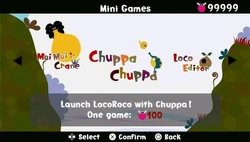
One of the 3 minigames.
MuiMui Crane[]
- Main article: MuiMui Crane
MuiMui Crane, grants additional Loco House parts and Pickories as prizes.
Chuppa Chuppa[]
- Main article: Chuppa Chuppa
Chuppa Chuppa, grants additional Loco House parts and Pickories as prizes.
Loco Editor[]
- Main article: Loco Editor
The Loco Editor is an unlockable feature in the game, creating an interactive course with a start and finish using the Loco House parts. LocoRoco has lots of other characters and enemies that have strange names.
Loco House[]
- Main article: Loco House
Controls[]
- These controls appear in the pause button
- L button - Tilt stage to the left
- R button - Tilt stage to the right
- L + R button - Flick the Stage
- Circle - A quick press and LocoRoco splits into small LocoRoco; Hold down to combine LocoRoco into bigger ones
- Start - Pause
- Select - Take a photo
Development[]

Kouno's original sketch for LocoRoco, drawn on a PDA.
LocoRoco was created by Tsutomu Kouno. Kouno had used a personal digital assistant (PDA) to sketch a game concept. He realized the planet-tilting aspect after seeing how rotating the phone with the sketch around would lead to a captivating game. Kouno felt the unit's shoulder buttons would be appropriate for the tilting controls. Kouno also wanted every aspect of the game to be unique.
Three concepts were part of Kouno's vision for the game, easy to play, fun, and to have dramatic visuals. Kouno sought not only to make the game accessible to younger players, but also to a wider, international audience. His team recognized that the simple tilting controls would be easily learned by children as well as those outside of Japan. This approach also led to the use of a new "language" for the music, instead of relying on Japanese works which would not be understood by the international audience.
The LocoRoco team began by creating different designs for the characters and world, including claymation, papercraft, and detailed textures, but settled on the resulting patterns not only to convey a "bright, cheerful" world. Kouno drew upon his interest in the natural world to design the other characters in the game. For example, one character was based on the appearance of his pet tropical fish.
Soundtrack[]
The soundtrack for LocoRoco is based on a fictional language created by Kouno to avoid alienating foreign players by using Japanese music. Kouno created the language by compiling a list of interesting words in katakana, then altering the words slightly to make them sound cool in Japanese as to mask their origins.
Kouno then sent the lyrics (along with some of his preferred reggae, soul, and R&B music) to the composers, Nobuyuki Shimizu and Kemmei Adachi, so they could complete the soundtrack. Kouno requested that the composers use as little electronic-sounding instruments as possible to give the music a feeling of "live sound". The team ultimately created about 60 songs to be used in the game.
The LocoRoco Original Soundtrack: LocoRoco No Uta contains 42 tracks from the game.
Versions[]
Demos[]
A downloadable demo of LocoRoco was released on the game's Japanese website. A demo localized for western countries was released in June 2006. It includes one level that will take the player around 5–15 minutes to complete, depending on the number of secret areas the player encounters.
A special Halloween-themed demo was released for download on October 26, 2006. It featured some exclusive graphics and objects, like Jack-o-lanterns, spirits, and more. Few puzzles were implemented.
A Christmas-themed demo was released for download on December 11, 2006. It featured some exclusive graphics like Santa's sleigh and more. A unique LocoRoco song is implemented.
Mobile version[]
A mobile version of LocoRoco, LocoRoco Mobile, was created for distribution in Japan in 2007. It has been renamed to LocoRoco Hi in western countries by Gamelion.
Remastered version[]
The original has been remastered for the PS4 in May 9, 2017 for the US.


